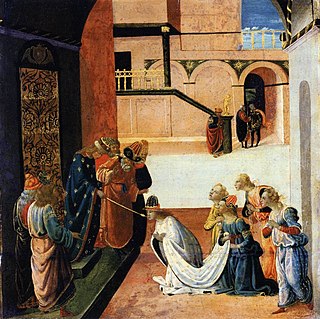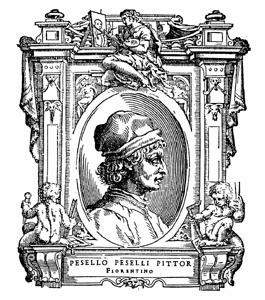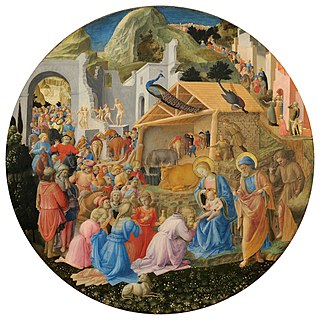
Fra Angelico, O.P. was a Dominican friar and Italian Renaissance painter of the Early Renaissance, described by Giorgio Vasari in his Lives of the Artists as having "a rare and perfect talent". He earned his reputation primarily for the series of frescoes he made for his own friary, San Marco, in Florence, then worked in Rome and other cities. All his known work is of religious subjects.

Domenico Veneziano was an Italian painter of the early Renaissance, active mostly in Perugia and Tuscany.

Lorenzo Monaco was a Sienese painter and miniaturist of the late Gothic to early Renaissance age, active principally in Florence. He was born Piero di Giovanni. Little is known about his youth, apart from the fact that he was apprenticed in Florence. He has been considered the last important exponent of the Giotto style, before the Renaissance revolution that came with Fra Angelico and Masaccio.

Luca Signorelli was an Italian Renaissance painter from Cortona, in Tuscany, who was noted in particular for his ability as a draftsman and his use of foreshortening. His massive frescos of the Last Judgment (1499–1503) in Orvieto Cathedral are considered his masterpiece.

Ridolfo di Domenico Bigordi, better known as Ridolfo Ghirlandaio was an Italian Renaissance painter active mainly in Florence. He was the son of Domenico Ghirlandaio.

Giovanni di Paolo di Grazia was an Italian painter, working primarily in Siena, becoming a prolific painter and illustrator of manuscripts, including Dante's texts. He was one of the most important painters of the 15th century Sienese School. His early works show the influence of earlier Sienese masters, but his later style was more individual, characterized by cold, harsh colours and elongated forms. His style also took on the influence of International Gothic artists such as Gentile da Fabriano. Many of his works have an unusual dreamlike atmosphere, such as the surrealistic Miracle of St. Nicholas of Tolentino painted about 1455 and now housed in the Philadelphia Museum of Art, while his last works, particularly Last Judgment, Heaven, and Hell from about 1465 and Assumption painted in 1475, both at Pinacoteca Nazionale (Siena), are grotesque treatments of their lofty subjects. Giovanni's reputation declined after his death but was revived in the 20th century.

Jacopo del Sellaio (1441/42–1493) was an Italian painter of the early Renaissance, active in his native Florence. His real name was Jacopo di Arcangelo. He worked in an eclectic style based on those of Botticelli, Filippino Lippi, and Domenico Ghirlandaio. The nickname Sellaio derives from the profession of his father, a saddle maker.

Francesco Pesellino, also known as Francesco di Stefano, was an Italian Renaissance painter active in Florence. His father was the painter Stefano di Francesco, and his maternal grandfather was the painter Giuliano Pesello (1367–1446), from whose name the diminutive nickname "Pesellino" arose. After the death of his father in 1427, the young Pesellino went to live with his grandfather whose pupil he became. Pesellino remained in his grandfather's studio until the latter's death, when he began to form working partnerships with other artists, such as Zanobi Strozzi and Fra Filippo Lippi. He married in 1442, and probably joined the Florentine painters' guild in 1447. In the following years he made for reputation with small, highly-finished works for domestic interiors, including religious panels for private devotional use and secular subjects for pieces of furniture.

The Annunciation of Cortona is a panel-painting altarpiece or retable by the Italian Renaissance painter Fra Angelico: once housed in the Church of Gesù of Cortona, it is now held at the Museo Diocesano in Cortona.

The Coronation of the Virgin is a painting of the Coronation of the Virgin by the Italian early Renaissance painter Fra Angelico, executed around 1432. It is now in the Uffizi Gallery of Florence. The artist executed another Coronation of the Virgin, now in the Louvre in Paris.

The Santa Lucia de' Magnoli Altarpiece is a painting by the Italian painter Domenico Veneziano, dated to around 1445–1447. Once placed at the high altar of the church of Santa Lucia dei Magnoli, Florence, it is now in the Uffizi Gallery in the same city. The large panel had originally a predella, which has been divided between museums in Washington, Berlin and Cambridge.

The Fiesole Altarpiece is a painting by the Italian early Renaissance master Fra Angelico, executed around 1424–1425. It is housed in the Convent of San Domenico, Fiesole, central Italy. The background was repainted by Lorenzo di Credi in 1501.

The St. Peter of Verona Triptych is a tempera-on-panel painting by the Italian early Renaissance master Fra Angelico, executed around 1428–1429. It is housed in the National Museum of San Marco in Florence, Italy.

Zanobi di Benedetto di Caroccio degli Strozzi, normally referred to more simply as Zanobi Strozzi, was an Italian Renaissance painter and manuscript illuminator active in Florence and nearby Fiesole. He was closely associated with Fra Angelico, probably as his pupil, as told by Vasari. He is the same painter as the Master of the Buckingham Palace Madonna. Most of his surviving works are manuscript illuminations but a number of panel paintings have also been attributed to him, including seven altarpieces and six panels with the Virgin and Child, along with some designs for metalwork.

The Adoration of the Magi is a tondo, or circular painting, of the Adoration of the Magi assumed to be that recorded in 1492 in the Palazzo Medici Riccardi in Florence as by Fra Angelico. It dates from the mid-15th century and is now in the National Gallery of Art in Washington D.C. Most art historians think that Filippo Lippi painted more of the original work, and that it was added to some years after by other artists, as well as including work by assistants in the workshops of both the original masters. It has been known as the Washington Tondo and Cook Tondo after Herbert Cook, and this latter name in particular continues to be used over 50 years after the painting left the Cook collection.

Andrea di Giusto, rarely also known as Andrea Manzini or Andrea di Giusto Manzini was a Florentine painter of the late Gothic to early Renaissance style in Florence and its surrounding countryside. Andrea was heavily influenced by masters Lorenzo Monaco, Bicci di Lorenzo, Masaccio, and Fra Angelico, and tended to mix and match the motifs and techniques of these artists in his own work. Andrea was an eclectic painter and is considered a minor master of Florentine early Renaissance art. Andrea trained under Bicci di Lorenzo as a Garzone. He painted his most significant works, three altarpieces, in the Florentine contado, or countryside; these altarpieces were created for Sant’Andrea a Ripalta in Figline, Santa Margarita in Cortona, and the Badia degli Olivetani di San Bartolomeo alle Sacce near Prato. Aside from his major altarpieces, Andrea painted several Frescoes over the course of his career. He, along with other minor masters, are also known to have provided several different types of art, including triptychs and frescoes, for Romanesque pievi, or rural churches with baptistries. Moreover, he was well known for several types of smaller craft objects, such as small tabernacles. He is said to have worked between 1420 and 1424 under Bicci di Lorenzo on paintings for Santa Maria Nuova. He is said to have worked with Masaccio in painting the Life of San Giuliano for the Polyptych of Pisa, including the painting of the Madonna and Child, in 1426. He also appears to have collaborated in 1445 with Paolo Uccello in the Capella dell'Assunta in the Prato Cathedral. In 1428, he is listed as a member of the Arte dei Medici e Speziali guild in Florence as "Andrea di Giusto di Giovanni Bugli". His son, Giusto d'Andrea, was also a painter and worked with Neri di Bicci and Benozzo Gozzoli. Andrea died in Florence in 1450.

Scenes from the Life of Saint Zenobius is a series of paintings by the Italian Renaissance artist Sandro Botticelli. Four panels from the series survive, which are now in three different museums. Each depicts three or more incidents from the life of Zenobius, an early Bishop of Florence who perhaps died in 417. The works are all in tempera on wood, and around 66 cm (26 in) high, though their length varies rather more, from about 149 to 182 cm.

Adoration of the Magi is a painting in tempera on wood panel by Luca Signorelli (1450–1523) and his assistants, executed c. 1493–1494, and now in the Louvre in Paris. It was probably the first painting he produced in Città di Castello, and originally hung over the main altar of the monastery church of Sant'Agostino. The surface displayed within the frame is 331 cm by 245.5 cm. In late 2022 it was not on display.
Dillian Rosalind Gordon OBE is a British art historian who worked as a curator at the National Gallery, London from 1978 to 2010, latterly as Curator of Italian Paintings before 1460. She lives in Oxford. She was appointed OBE in 2011 for services to Early Italian Painting. She has authored and co-authored many books, including several National Gallery catalogues.

The Procession of the Magi, more recently and more precisely known as King Balthazar's Journey to the Holy Land is a mid-1440s or late 1440s painting by the Italian painter from Tuscany, Zanobi Strozzi. It is now in the Musée des Beaux-Arts of Strasbourg, France. Its inventory number is 261.
























